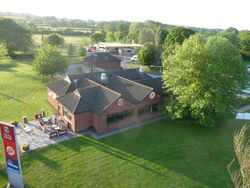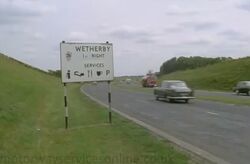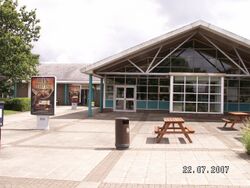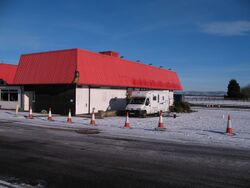Trunk road service area

Trunk road service area (TRSA) is one of the most commonly used terms to describe a service area which provides facilities for traffic using a major road that is not a motorway.
Highway authorities use a number of different terms to refer to this, which all broadly describe the same thing:
- in the 1980s they sometimes called it a major road service area (MRSA, not to be mixed up with MSA or MRA, or even the other MRSA)
- sometimes they say roadside service area (RSA)
- in 2013, for no practical reason, the Highways Agency started using the phrase APTR service area (meaning "all-purpose trunk road")
An explanation of exactly what is and isn't included is covered below.
There is no particular format to a TRSA: some are bigger than the motorway sites, while others consist of just a few petrol pumps. Most TRSAs used to avoid the brand names usually seen on the motorway, but now it's becoming common to find several brand names stuffed inside a small building.
Motorway Services Online lists every TRSA that is known to have official signage, in addition to a few other sites we frequently receive questions about.
Definition
See also: What is a service area?
If you follow the term "TRSA" to the letter, it is fairly black and white. In Britain, a "trunk road" is a road which is maintained by the national highway authority. When a service area enters into a Traffic Signs Agreement with the highway authority, it is regarded as official and confirms its TRSA status.
Strictly speaking, most motorways are a type of trunk road, but the phrase "TRSA" deliberately ignores motorways which have their own class of service area. This is probably why the Highways Agency wanted to introduce the term "APTR", which does specifically exclude motorways.
The big complications come from all the other circumstances. Roads which are not trunk roads are maintained by the local highway authority, who very rarely provide full signage for a service area on their patch. When they do, it's normally because the road used to be a trunk road and the signs were never updated. There are so few examples it's probably not worth inventing a new term, so "TRSA" is often (wrongly) used instead.
Any facility which caters for passing traffic could claim to be a "service area". They can call themselves what they like, but that's why we reserve technical terms like "TRSA" for the places which meet the required standards and are recognised by the highway authorities.
In Ireland there are a small handful of service areas on "national routes", the equivalent of a "trunk road". In the absence of an official term from the Irish authorities it is again easier to keep (wrongly) using "TRSA".
We are not the only ones to use these terms. Operator Moto frequently describes themselves as "a provider of MSAs and TRSAs". Likewise Applegreen UK say that they hold "MSA and TRSA assets".
Facilities and Regulations

As set out in Circular 02/2013, TRSAs must provide at least:
- Fuel
- Hot drinks and hot food
- Two hours free parking
- Free toilets, hand washing facilities and baby-changing facilities
This must be available every day from 8am until 8pm, except for Christmas Day, Boxing Day and New Year's Day. A TRSA is limited to two adjoining premises, however when you have a number of buildings sharing the same site it can be difficult to describe which ones are part of TRSA and which are just a hotel that happens to be built next door.
This causes two issues: firstly, while TRSAs have to provide free parking and free toilets, there is nothing stopping them causing confusion by also providing paid parking and customer-only toilets. Secondly, in order to receive official signs the owner has to enter an agreement with the Secretary of State, but the motorist has no way of knowing which owner has entered the agreement: is it the building on the left or the right?
The 2013 policy was a significant relaxation of the previous 2008 regulations, which had prevented a TRSA from doubling-up as any other facility. Now they were allowed to provide virtually anything, meaning a building could be both a service area and a theme park, if it wanted to.
Applications for a new facility on a fast road will generally be rejected unless road signs will be provided to give drivers plenty of warning that the exit is coming up. This means new services must meet the criteria outlined above, or they can't be built at all.
Spacing
Historically, motorway services were arranged entirely by the government, which has created a fairly organised system. A-road services have been left entirely to the free market, which has created a complicated mess.
The simple headline is that trunk roads should have a service area every 14 miles or 30 minutes (whichever is the lesser). Previous policies have stated every 12-25 miles (1974 DoE statement; PPG13 1994). Roads with a speed limit of 40mph or less are excluded from this as they tend to be in urban areas with lots of facilities available.
Department of Transport, 1987
Planning policy tends to prefer infrequent, large services to regular, small ones. This is partly because they are less disruptive, but mostly because the entrance to service areas can be dangerous and it is easier to deal with that risk if it's concentrated on one place. This policy was confirmed in the government policy statement in 1987. For the same reason, it's preferred if new A-road services are built at existing junctions, and even better if they are down a side-road.
New TRSAs are not considered if they involve turning right across a dual carriageway, and a well-aligned junction is required if traffic is expected to turn right across a single carriageway. Otherwise they will be ignored, like at Willoughby Hedge.
What makes things complicated is that A-roads tend to have lots of old, small facilities, and it can be difficult to work out exactly what is lacking or where. This gets even harder when some of them close, or the road gets diverted away from some of them. Finally, local authorities tend to take a short-sighted approach to the issue, and will only consider the portion of the A-road which is on their patch. The county council's local plan will usually identify areas where a new service area could be acceptable, while if the planning application goes to an appeal then the inspector may start looking at the whole road and what's needed.
England's national highway authority are encouraged to find stretches of roads which could benefit from a new service area. This has previously been achieved as part of a route management study (RMS), where the Highways Agency looked at the performance of a particular road. In 2010 the old Highways Agency published a review of all trunk road facilities, and made suggestions for some of them to be upgraded or signposted. This was an exception rather than their usual approach, and they continue to maintain a hands-off policy.
In the past there was a simple test to work out where a new service area was needed: local residents would be continually hassled by people knocking on their door and asking them to call for assistance. In the era of mobile phones this doesn't happen, but instead we rely on fast food companies to identify spots where they think they could make a profit.
History

Until the motorway network began to be developed, it had always been a given that roads would have restaurants, hotels and petrol stations along them wherever they were required. Even when a new road was built, entrepreneurs would quickly open businesses there, like at Kings Worthy - which was probably the first service station as we would recognise it today.
The motorways were different. Motorway regulations prevented businesses from opening up alongside them, and instead service stations had to be sanctioned by the government. With the motorway service area operators fighting over contracts, Fortes realised they would have an easier time building on A-roads, where they could get their name out there without the hassle of government regulation.
This gave us sites such as Oxford Peartree, Barnsdale Bar and Grantham North. Granada later joined in with the likes of Saltash and Musselburgh, and most recently Extra have tried.
There was lots of experimentation during this early motoring era. At Wetherby, a sign advertised the "services" available in the town - not a service area as we would recognise it but the start of people becoming familiar with the concept.
In the 1970s, the Department for the Environment acknowledged that simple rest areas on A-roads were popular, but said it didn't have the money for them. Instead, in some regions, it told developers they would advertise their facility if it was open 24 hours. These signs were normally blue.
In 1982 a green sign was created for A-road services. This was arguably the point at which the idea became official, as there was now a clear system under which anybody who qualified could apply for road signs.
Little Chef Impact
By the late 1970s, Little Chef and the rivals it had inspired were growing at a phenomenal rate. Ancient inns and cafés across the country's A-road network were being offered large amounts of money to sell up and the chains had the UK covered.
There appeared to be no consistency with Little Chef. Big or small, old or new, a range of facilities or just one. But by being everywhere they did bring some consistency to the disorganised facilities on A-roads, and by the 1990s Little Chef were rolling out a format of sites which resembled a small motorway service area. Forte revealed that they had a whole team dedicated to studying major A-roads, and ensuring they were well covered with Little Chefs.
As motorway sites started to have their large restaurants pulled out, Little Chef hung on in there, keeping the A-roads looking different. In 2018 the final remaining Little Chefs started to be replaced with coffee shops and fast food outlets.
Motorway By Stealth

See also: Stealth services
Arch rivals Granada and Forte discovered a trick where they would build a TRSA at the junction of an A-road and a motorway, thereby being able to serve a motorway while avoiding the difficult motorway regulations. Sometimes they would hope just being there would attract traffic, while other times they would beg for motorway signs to be added.
Markfield and Tiverton are examples of the former while Chieveley and Pease Pottage are examples of the latter.
By 2010, the existence of sat navs and websites like Motorway Services Online had inadvertently encouraged some developers to not bother applying for motorway signs and to instead rely on word of mouth, causing the "motorway by stealth" trick to return. New examples such as Glews, Markham Vale and Frontier Park aren't TRSAs because they both aren't on an all-purpose trunk road and they don't have any official signs, but they do look very similar.
A Generic Description Of A Facility
The last three examples above ought to come under this category, which the Traffic Signs Regulations and General Directions (TSRGD) gives the catchy title of "a generic description of a facility".
Official signs placed on public roads aren't allowed to use brand names like "Costa". As a result, some councils will use a sign saying "Services" because they can't think of any other word to use. This means "Services" signs can crop up in strange places, like the car park at Gatwick Airport, where it's pointing at what used to be just a McDonald's.
In order to count as an official service area, the owner has to have entered into an agreement which has allowed signs to Diagram 2313.1 (the one with symbols) to be installed. Just having the word "Services" and an arrow isn't the same thing, as those ones aren't regulated in the same way.
Upgrading and Closing

When a trunk road is upgraded to a motorway, TRSAs are usually compulsory purchased and demolished. Occasionally the government (pre-1992) or a developer (post-1992) will argue that the new road needs a service area, and if possible a new MSA will be set up in roughly the same place, which is what happened at Gretna Green.
In 2008 a section of the A74 was upgraded to M6, narrowly avoiding Todhills. Although no case was made for it to become a motorway service area, it was agreed that it could become the first of a new generation of rest areas.
Sometimes a road will be realigned as traffic levels change, with the new road avoiding an existing TRSA. Where this happens the owner will try to see signs from the new road pointing to their site, but if for whatever reason this can't happen, they can apply for compensation.
On the other hand, as TRSAs are less regulated than MSAs, it isn't uncommon for new companies to drop in and out. If a TRSA completely closes, their exit will be closed off and any plans to use the site for something else will normally be rejected.
Road Signs
Since 2002 TRSA signs have been in black-on-white, and are explained in detail on the A-road Signs page.
Before then the signs were all in white-on-green. Many white-on-green signs still exist, and still constitute an official service area, even if the signs themselves are outdated and required to be replaced.